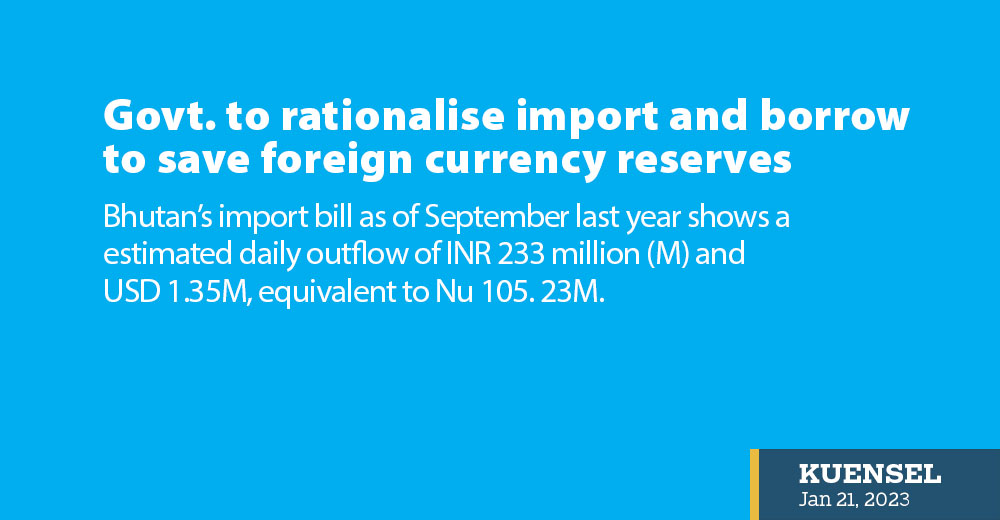Thukten Zangpo
Bhutan’s import bill as of September last year shows a estimated daily outflow of INR 233 million (M) and USD 1.35M, equivalent to Nu 105. 23M.
The figures could be high if we consider the country’s debt obligations of INR 7 billion (B) and convertible currency debt.
Soaring import bills and appreciating USD against the Ngultrum saw the country’s foreign currency reserve decrease.
The Royal Monetary Authority’s provisional figure showed the country’s reserve at USD 729.7M as of September 2022, enough to meet 13.11 months’ essential imports.
The reserve decreased by over 40 percent from the same month the previous year, which was at USD 1.29 billion (B).
Finance Minister Namgay Tshering said that import bills for the first six months in 2021 increased by two-fold compared to the same period in 2022. At the same time, imports continued to increase.
The country’s import bill of Nu 93.03B as of September 2022 surpassed one year’s import of Nu 90.23B in 2021, which constituted about 70 percent of import from India.
At the same time, the value of exports, including electricity, stood at Nu 44.9B.
The trade deficit stood at Nu 48.14B, a rise by Nu 15.9B in 2021.
“The country’s trade deficit is a chronic problem and we need to resolve it,” Lyonpo said, adding that the country is facing a critical challenge today because of financial conditions tightening globally, staggering inflation, and USD appreciating against Ngultrum or INR.
USD appreciated by about 10 percent in September 2022 from the same month the previous year.
Despite the reserve meeting the 12-month essential import requirement as mandated by the Constitution, Lyonpo said the country cannot be complacent and that the government would take short-term, medium-term, and long-term measures to protect the reserve.
For the short-term, Lyonpo said that the country would rationalise imports; the government implemented a moratorium on the import of luxury cars.
For the medium-term, the government, he said, would have to look for concessional borrowings.
“The government needs to ensure that the economic activities do not grind to a standstill, but we have to maintain the reserve,” Lyonpo said, adding that the government is exploring options to get a better deal to build the reserve.
Bhutan graduates from the list of least-developed countries status by 2023, which means grants inflow will substantially decline.
To earn the convertible currencies, Prime Minister Dr Lotay Tshering said the country has to bring in more foreign direct investments and export domestic products.
However, the 101 FDIs in the country are not making profits because of no conducive environment, Bhutanese not having the required skills to run the business, and no proper payment gateway.
Talking about the gross domestic product (GDP), Lyonpo Namgay Tshering said that the country’s twin deficits—trade deficit and current account deficit—should be fixed at the situation rather than focusing on the country’s GDP growth.
Bhutan’s GDP, he said, is derived from the expenditure approach and for GDP growth, the government taking expansionary fiscal policy has to pump in more money into the economy.
The government’s spending contributes to about 38 percent of the GDP.
However, Lyonpo said that the government should protect the reserves.
Lyonpo said Bhutan’s GDP is projected to grow at 4.3 percent in 2022 and between 3.5 to 4 percent this year.


